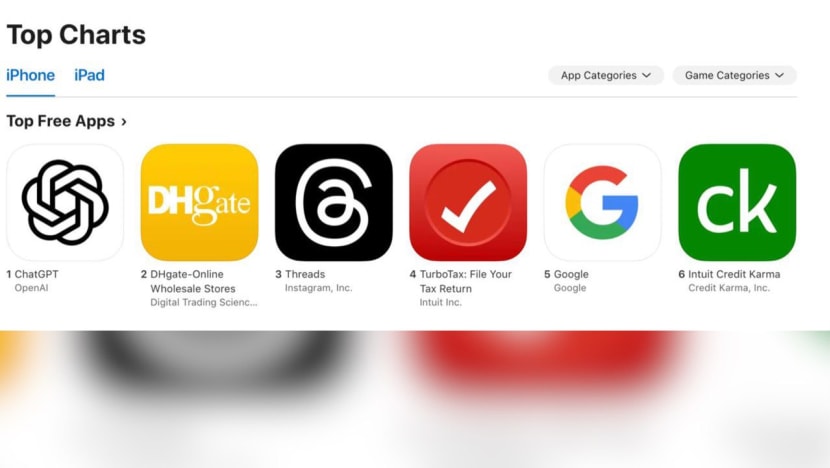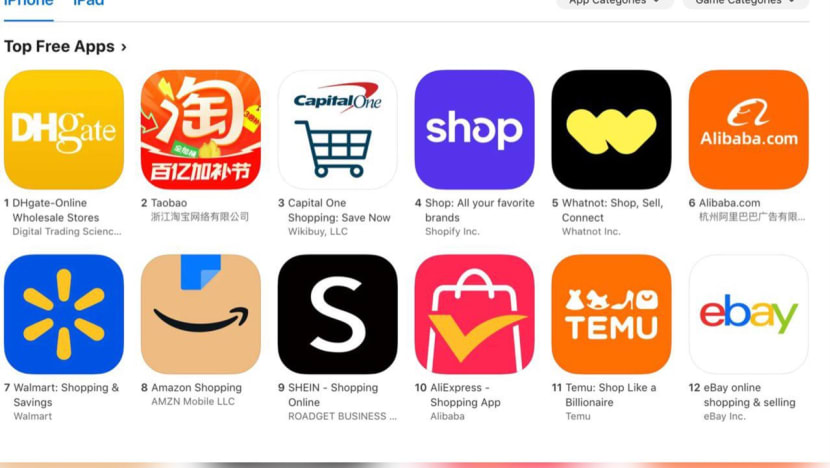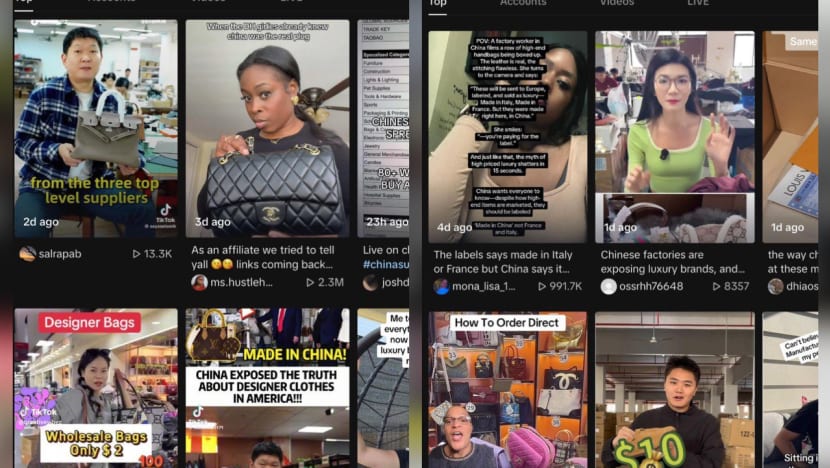How US shoppers are racing to dodge tariffs with a viral Chinese app
SINGAPORE: Faster than you can say “new tariffs”, American shoppers are flocking to Chinese e-commerce apps in search of the cheapest prices on sneakers, clothes and luxury bags - in an attempt to outmanoeuvre price hikes sparked by US President Donald Trump’s ongoing tariff war.
The spike in downloads comes as US consumers rush to place orders before May 2, when the de minimis exemption expires for low-value imports from China - which could see parcels valued at US$800 or below subject to taxes.
Chinese e-commerce companies have already warned US shoppers to expect price hikes - and shoppers are definitely worried.
On TikTok, users have been scrambling for clarity. “If we order now and they get to the US after (May 1), are they going to be subject to the new tariffs?” one shopper asked.
“I have a cart … but I’m worried about them arriving post-tariffs,” another shopper added.
“This is obviously triggered by the tariff war between China and the US where consumers are concerned about rising costs that are coming and (will) affect their lives in future,” Jason Yu, managing director of CTR Market Research in Beijing, told CNA.
“They are worried, so they are searching for different sources of the product.”
And they are going straight to the source, buying directly from Chinese apps.
Checks by CNA on Thursday (Apr 17) showed Chinese apps dominating Apple’s US App Store. Six of the top 11 shopping apps being downloaded by US users were from China.
Alongside popular apps like Temu, Taobao and Shein, Chinese app DHgate - also dubbed the “Little Yellow App” - has become an overnight success, placing second in downloads after ChatGPT on Apple’s list of free iPhone apps, despite barely cracking the top 350 just days before.


DHgate, a Beijing-based business-to-business (B2B) e-commerce platform founded in 2004, directly ships factory-made goods from China under the de minimis rule.
US downloads increased by a staggering 940 per cent from its 30-day average, according to data from app intelligence firm Appfigures, cited by media company Cailianshe.
At the same time, analysts warned that the boom could also backfire as platforms face scrutiny over intellectual property and quality.
SPILLING THE TEA ON LUXURY BRANDS
A global digital information war is also taking place, with Chinese content creators flooding platforms like TikTok, using videos to pull back the curtain on China’s invisible role in the global supply chain.
Their message: asking US shoppers why they were paying hundreds of dollars more for little more than a logo.
Snappy reels and videos filmed in various factory and production settings feature hosts and sellers comparing luxury Western brands to alleged unbranded counterparts, claiming that products were made in the same factories, using the same materials - just without the expensive brand marketing.
A video from a creator with the handle Sen Bags gave viewers a tour of its production floor in Guangzhou and stated that it has been producing for global luxury brands for decades.
“Luxury can be reasonable.”
The trend isn’t entirely new - but amid rising tariffs and renewed US-China trade tensions, this content is seeing renewed interest, resonating with a new wave of price-conscious buyers.
In a resurfaced viral TikTok video from 2024, a creator from The Rohrs Team, which focuses on investment consulting, claimed Swiss watches were commonly made in China, despite their prestigious labels.
“You’re imagining this bespoke factory in Switzerland with mountains in the background … That’s not the case,” the creator said, noting that only one high-cost component is added in Switzerland to meet the 60 per cent cost threshold required for the “Swiss Made” label.
Similar comments were made in another viral TikTok video that drew more than 10,000 likes. Better known online as The Watch Regulator, the creator - a former watch technician who claims to have worked for one of the world’s largest Swiss watch companies - lifted the veil on the industry’s opaque sourcing practices.
“This has been going on for at least 50 years. I worked on some of their watches dating back to the 70s that were mainly made in China,” the creator said, adding that he had been fired for speaking publicly.
A TikTok user said: “I’m just happy people are starting to realise that it’s not worth spending thousands of dollars to buy something just because of the logo.”

But the trend is doing more than just highlighting price differences, it is revealing how little people know about global commerce and supply chains, said Chinese tech analyst Ma Rui, who also hosts the Tech Buzz China podcast.
“That gap in understanding is now being filled rapidly and publicly, with Chinese sellers marketing (products and goods) directly to overseas shoppers - videos that might have once been confined to internal sourcing meetings are now being used to court US buyers and reframing how people think about price, quality and authenticity.”
“Quite a number of those fashion retailers outsource their manufacturing to China,” Yu said, adding that while parts of the process might be done in places like Europe, a lot of basic production was still made in China.
The reality is that manufacturing and branding are no longer geographically aligned, he added.
That disconnection, between where things are made and how they are sold, is exactly what the “factory spill” trend lays bare.
“There is no doubt that indeed, some factories are capable. You are basically making the same items and a brand is slapping the logo on it,” Ma said.
But she warned against taking every viral claim at face value.
Price alone, does not tell the full story, Yu added, saying that branding, marketing and the symbolic (emotional) value associated with a particular brand or label play bigger roles.
“Brands provide much more than just the basic product. It’s not really equal to the product,” Yu said.
“MADE IN CHINA” IS COMING BACK, BY CHOICE
For decades, “Made in China” products have been seen as cheap, mass produced, and of lower quality.
But the global economy has greatly benefited from China’s lower labour costs and mass production - making everything from toys, clothing and electronics to cars, kitchenware and jewellery.
“For most of the mainstream products, the manufacturing cost is just a small fraction of the total price they are charging to consumers in the US. Many of them are actually produced in (Chinese cities and provinces like) Guangdong or Fujian,” said Yu.
“In that way, if you are sourcing directly from China as a product, then the price is actually indeed very, very low.”
Experts said the logic has also influenced spending habits. Platforms like Taobao and Shein have become staples among Gen Z consumers, not just in China but also other countries.
“Consumers are much more savvy and advanced in terms of exploring different options,” Yu said. “They are using TikTok to buy things and DHgate to actually get products at really good bargain prices.”
Ma said the shift is practical. “People are hoping that it will be less expensive because if you go straight to the factory (source) and cut out the middleman, it’s still cheaper, even with tariffs and charges.”
Chinese platforms might have the competitive edge when it comes to pricing but global rivals offer what many consumers still value: consistency and trust.
Giants like Amazon won’t just sit back, Yu said. “Amazon will be able to find a way to defend their position. They will negotiate with vendors in Asia and other continents to at least maintain their competitive edge.”
“It’s not just about the price. It’s also about assurance, the sense of safety and shopping experiences which go beyond the price itself,” Yu added.
CHALLENGES AND PITFALLS
Shoppers might be rejoicing but things can still go wrong, experts said.
Chinese platforms like DHgate were not built for use by individual consumers, Ma said.
“If you are buying from a factory, or going through other platforms that are really made for business-to-business purposes … things go wrong,” Ma said.
“For example, (the process) is not nearly as fast and could be a big hassle - shipping containers could get lost.”
Speed and service experience are also not guaranteed.
“Unless this changes, which would require factories and the platforms to take this new demand really seriously, they would need to invest resources into customer service,” Ma said, adding that returns and exchanges and after-sales care would be even more uncertain.
“They are used to a certain volume … now it's so much bigger,” Ma said. “Do they have the staff? Are they going to be able to really control the quality?”
“How (will such vendors) deal with returns? How do they deal with aftercare services?”
“If they are selling to a business, that is very different from selling (directly) to the consumer.”
“They're not used to working with consumers … they haven't quite figured it out.”
Recent comments on viral TikTok videos showed some users pushing back against DHgate, saying its products often fell short when it came to quality. A “dupe” is clearly not the same as an original product, they said, even if it might look similar at first glance.
Experts said concerns are rising over counterfeits and mislabeling.
Platforms could soon face regulatory and legal scrutiny, both from governments and brands, said Ma.
“If this gets any bigger, I do think brands are going to go after (them) … for malicious marketing,” she said.
Additionally, she said platforms bear the burden of compliance, especially when it comes to policing sellers and counterfeit claims.
“Globally, platforms are supposed to kick off - or at least temporarily ban - sellers that violate IP rules,” Ma said. “That’s a lot of compliance burden. And I’m not sure these platforms are equipped to handle that scale yet.”
But adapting to a new post-tariff environment will be crucial, Ma added - and Chinese merchants are resilient.
“As long as they see a rational reason for being able to sell, they are going to pursue it - no matter how much work it takes.”
“If these tariffs are in place for a while, Chinese suppliers are going to have to move in that direction. They are going to do whatever it takes to survive - even if it means changing their business model and adding a lot of customer support, they'll do it. They have no other options.”
Yu put it more bluntly: “(Trump) has underestimated what American consumers can do to circumvent the policies.”
免责声明:投资有风险,本文并非投资建议,以上内容不应被视为任何金融产品的购买或出售要约、建议或邀请,作者或其他用户的任何相关讨论、评论或帖子也不应被视为此类内容。本文仅供一般参考,不考虑您的个人投资目标、财务状况或需求。TTM对信息的准确性和完整性不承担任何责任或保证,投资者应自行研究并在投资前寻求专业建议。
热议股票
- 1
- 2
- 3
- 4
- 5
- 6
- 7
- 8
- 9
- 10